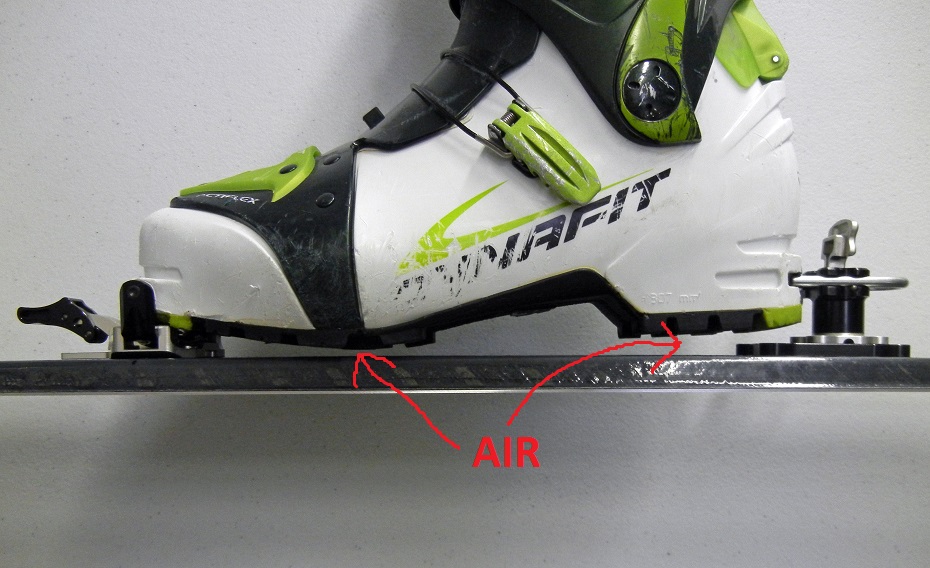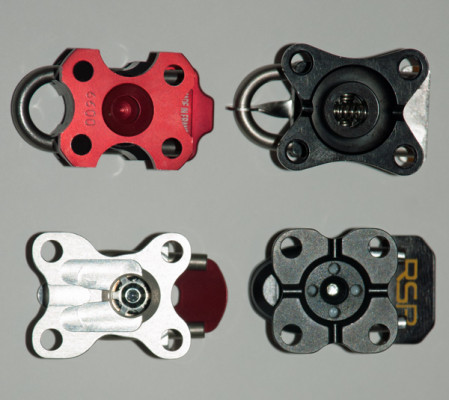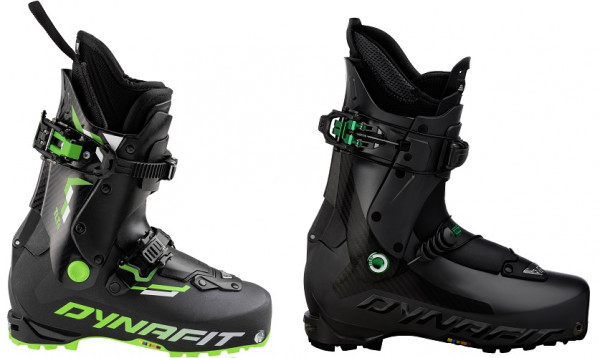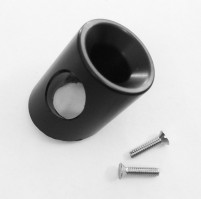1/5/2020 Binding Pin Heights
Alpine skiers can be surprised to learn that tech bindings essentially suspend your boot in the air above your ski. Your weight is not resting on the ski at all, but rather is supported by metal pins that insert into reinforced holes found on Dynafit compatible ski boots. It can be important to consider just how far off the deck your toes and heels are floating, since this can affect how your weight is balanced over your skis.

The height of the pins that hold your boots is not typically published by binding manufacturers. However, this can be good information to know if you are trying to determine the angle of ramp between your ski and ski boot. As such, we took to measuring them. See below for a list of pin heights in millimeters for common tech bindings, accurate to within one millimeter:
| Binding | Toe Height | Heel Height | Delta |
| ATK Revolution | 29 | 29 | 0 |
| ATK Revolution Brake | 29 | 28 | -1 |
| ATK SL World Cup | 30 | 29.5 | -0.5 |
| ATK Trofeo | 30 | 30 | 0 |
| ATK Trofeo Brake | 30 | 28 | -2 |
| ATK Kuluar Superlite | 30 | 36.5 | +6.5 |
| ATK Kuluar | 30 | 41.5 | +11.5 |
| ATK Haute Route | 30 | 36.5 | +6.5 |
| ATK Haute Route Plus (2024+) | 33.5 | 36.5 | +3 |
| ATK Haute Route Plus (2023) | 30 | 36.5 | +6.5 |
| ATK Hy | 30.5* | 37.5* | +7 |
| ATK Candy 5 | 33.5 | 41.5 | +8 |
| ATK Crest (2024+) | 33.5 | 45 | +11.5 |
| ATK Crest (2023-) | 30 | 41 | +11 |
| ATK Crest AP | 30 | 45 | +15 |
| ATK V-Crest | 33.5 | 41.5 | +8 |
| ATK RT 8/10 Evo | 30 | 44.5 | +14.5 |
| ATK RT 11 Evo | 34.5 | 44.5 | +10 |
| ATK C-Raider | 33.5 | 43.5 | +10 |
| ATK Raider (2020+) | 31.5 | 43 | +11.5 |
| ATK Raider SL | 33.5 | 45 | +11.5 |
| ATK Raider Evo | 33.5 | 44.5 | +11 |
| ATK Freeraider Evo | 37.5 | 44.5 | +7 |
| ATK Freeraider | 31.5 | 43 | +11.5 |
| Atomic Backland | 30.5 | 39 | +8.5 |
| Atomic Summit | 33.5 | 41 | +7.5 |
| BD Helio 110 | 30 | 29.5 | -0.5 |
| BD Helio 145 | 30 | 30.5 | +0.5 |
| BD Helio 180 | 30 | 36.5 | +6.5 |
| BD Helio 200 LT | 30 | 31.5 | +1.5 |
| BD Helio 200 | 30 | 36.5 | +6.5 |
| DPS L10 | 30 | 36.5 | +6.5 |
| DPS R10 | 35 | 43 | +8 |
| DPS H10 | 34 | 44.5 | +10.5 |
| DPS R14 | 35.5 | 43.5 | +8 |
| Dynafit Blacklight | 30.5 | 39.5 | +9 |
| Dynafit Blacklight 2.0 / Pro | 34.5 | 42.5 | +8 |
| Dynafit DNA / Mezzalama | 30 | 33.5 | +3.5 |
| Dynafit Low Tech Race | 28.5 | 28.5 | 0 |
| Dynafit LTR 105 | 30 | 30.5 | +0.5 |
| Dynafit Radical ST/FT | 35.5 | 50.5 | +15 |
| Dynafit Radical ST Alu | 37 | 53 | +16 |
| Dynafit Radical 2.0 | 38 | 51 | +13 |
| Dynafit Ridge | 37.5 | 44.5 | +7 |
| Dynafit Rotation 7 | 38 | 50.5 | +12.5 |
| Dynafit Rotation 10/12 | 38 | 51 | +13 |
| Dynafit Speed/Speedfit | 31 | 38.5 | +7.5 |
| Dynafit Seven Summits[+] | 33.5 | 45.5 | +12 |
| Dynafit Speed Turn | 28.5 | 44 | +15.5 |
| Dynafit Speed Turn 2.0 | 30.5 | 45 | +14.5 |
| Dynafit Speed Radical | 30.5 | 45 | +14.5 |
| Dynafit Speed Superlite | 28.5 | 31 | +2.5 |
| Dynafit Superlite 150 | 30 | 36 | +6 |
| Dynafit Superlite 2.0/175 | 28.5 | 36 | +7.5 |
| Dynafit TLT Expedition | 28.5 | 31.5 | +3 |
| Dynafit Vertical ST | 33.5 | 49.5 | +16 |
| Fritschi Tecton | 41.5 | 51.5* | +10 |
| Fritschi Vipec | 41.5 | 51.5 | +10 |
| Fritschi Xenic | 32.5 | 47 | +14.5 |
| G3 Zed 9 / 12 | 39 | 43 | +4 |
| G3 ION | 40.5 | 51.5 | +11 |
| Grizzly GR98/Olympic | 27.5 | 26.5 | -1 |
| Hagan Boost | 34 | 43.5 | +9.5 |
| Hagan Core | 31.5 | 42.5 | +11 |
| Hagan Core Evo | 31.5 | 45 | +13.5 |
| Hagan Core Pro | 31.5 | 43.5 | +12 |
| Hagan Pure | 30 | 41 | +11 |
| Hagan Pin Up Evo | 30 | 44.5 | +14.5 |
| Hagan Ride | 31.5 | 36.5 | +5 |
| Hagan ZR / Ultra | 28 | 27.5 | -0.5 |
| Kreuzspitze EL | 29 | 35 | +6 |
| Kreuzspitze SCTT | 28.5 | 28 | -0.5 |
| Kreuzspitze RS | 29 | 28 | -1 |
| Kreuzspitze GT | 29 | 28.5 | -0.5 |
| Kreuzspitze GT 2.0 | 29.5 | 28.5 | -1 |
| La Sportiva RSR | 28 | 28.5 | +0.5 |
| Marker Alpinist | 34 | 36 | +2 |
| Marker Cruise | 34 | 48.5 | +14.5 |
| Marker Kingpin | 41 | 50.5* | +9.5 |
| Plum 99 | 30.5 | 28 | -2.5 |
| Plum 120 | 30.0 | 28.5 | -1.5 |
| Plum 135 / 145 | 27.5 | 29.5 | +2 |
| Plum 140 | 30 | 30.5 | +0.5 |
| Plum 150 | 30.5 | 31.5 | +1 |
| Plum 165 | 27.5 | 31 | +3.5 |
| Plum 170 | 30.5 | 35 | +4.5 |
| Plum S170 | 30.5 | 35.5 | +5 |
| Plum Oazo | 30.5 | 34.5 | +4 |
| Plum Serak | 30.5 | 34.5 | +4 |
| Plum Pika | 30.5 | 39 | +8.5 |
| Plum WEPA | 31 | 42.5 | +11.5 |
| Plum Caribou / Karibou | 40 | 47.5 | +7.5 |
| Plum Guide | 29.5 | 47.5 | +18 |
| Plum Summit | 40 | 53.5 | +13.5 |
| Plum Yak | 39 | 47.5 | +8.5 |
| PG U77 | 28.5 | 32.5 | +4 |
| RC1 by PG | 24 | 30 | +6 |
| Salomon MTN | 30.5 | 39 | +8.5 |
| Salomon Summit | 33.5 | 41 | +7.5 |
| Ski Trab Gara Titan | 31 | 30 | -1 |
| Ski Trab Titan Brake | 31 | 31 | 0 |
| Ski Trab Titan Vario 1 / Light | 31 | 33.5 | +2.5 |
| Ski Trab Titan Vario LT Adj. | 35.5 | 39 | +3.5 |
| Ski Trab Titan Adjustable | 35.5 | 42.5 | +7 |
| Ski Trab Titan Vario.2 | 35.5 | 44 | +8.5 |
| Ski Trab TR Race | 29.5 | 30 | +0.5 |
| Ski Trab TR Adjustable | 29 | 35 | +6 |
| Ski Trab TR-2 | 36 | 44* | +8 |
| Slatnar ST Touring | 29.5 | 40 | +10.5 |
| Tyrolia Almonte PT | 31.5 | 42 | +10.5 |
* Estimate of where pins would be.
The key number in the above table is pin height delta found in the last column. This number is an indication of how much higher your heel is than your toe. Higher deltas can shift your weight forward on the ski, which can be an unnatural feeling for some skiers. Somewhat counterintuitively, those skiers tend to end up in the “back seat” since their bodies naturally compensate with additional knee flex and backwards lean. While this is an OK position in certain situations, overall it causes poor control, unnecessary knee strain, and tired quads.
We would be remiss to not mention adjustment plates in this discussion. A tool for skiers with a quiver of boots, these plates are mounted under the toes (uncommon) and heels (common) of race bindings to provide some fore/aft adjustability. Since they are not zero inches thick, they will directly alter the pin heights of the bindings mounted on them. Here are the thicknesses of some popular adjustment plates, which are added to the binding pin heights:
| Adjustment Plate | Thickness |
| BD Helio | 5.5mm |
| Dynafit | 5mm |
| Hagan | 5mm |
| Kreuzspitze | 5.5mm |
| La Sportiva | 5mm |
| Plum | 6.5mm |
Now before you go calculating millimeters and adding shims, take a step back to realize there is no “correct” pin height delta. Alpine ski racers are used to aggressive postures and tend to prefer driving from the front seat. Casual powder hounds often like their weight back a bit as they surf through fluff with their tips high. Cross-country skiers tend to prefer an upright stance, and don’t want to be nudged in any direction. Lou Dawson established a baseline goal for himself to be roughly +12mm delta based on early Dynafit binding models.
We think you shouldn't worry too much about a few millimeters. However skier balance is additionally affected by other variables, such as the forward lean of boot cuffs, ramp built into the boot sole, and stock or aftermarket insoles. If all of these variables point in the same direction, it is easy for your balance to get out of whack. This can often be a relatively straightforward fix that involves mounting shims or toe plates under your bindings. If you’re looking for advice on your particular setup, please send us a message.
This article was originally published on 3/31/2014 and was last updated on 1/5/2020.Comments
Thanks!
I have one here, and I get measurements closer to 9mm.
Can I screw the Hagan Core 12 EVO toe piece with an ATK AL14 4mm toe spacer to an ATK R16A adjustment plate? He said yes, since the adjustment plate is secured to the ski in a wider bolt pattern, and the toe piece is secured to the adjustment plate with machine screws, it seems completely do-able.
Except it isn't. The machine screws that you would need to secure the toe piece (with spacer) to the adjustment plate do not exist. The machine screws that come with the R16A (5.7 x 9.5mm t-20 countersunk screws) are only long enough to secure the toe piece directly to the adjustment plate, and are 100% proprietary to ATK. Presently, they do not make the screws I would need (5.7 x 13.5mm t-20 countersunk). No one does. Don't bother checking a hardware store either, you'll be wasting your time.
Will there ever be a full featured touring binding that has zero binding delta? I get it- if you have a long foot, you don't have the delta problem. But for all us skiers with short BSL's and heel lifts in our boots, we do, and there is a HUGE vacuum in this market. Make a decent one and I'll be your first customer. You can even have my old bindings.
My measurements show that Vipecs are approx. 2mm higher in the heel than tectons. Check done on recent models.
In the past I had all kind of Dynafits with 15 - 17 mm delta built-in.
After mounting a pair of Kingpins I immediately noticed positive effect of lower delta.
Right now I am ready to buy another set and I am still keen on old turn models ( at the moment I am on Turn 2.0 ).
Do you maybe know what is the delta of Radical turn 92?
I am not able to find this info.
Thanks,
Best regards,
Rok
Thanks for all this information! I wish I would’ve studied this closer before buying speed radicals!
Anyway, what toe riser would you suggest to reduce ramp angle for them along with the screws please?
Thanks!

1/16/2020
Hole Pattern Recognition










